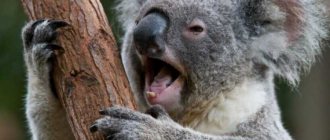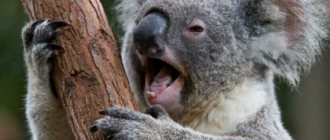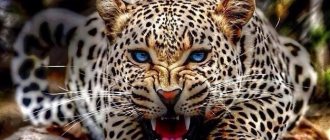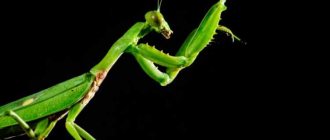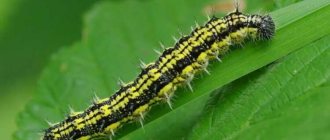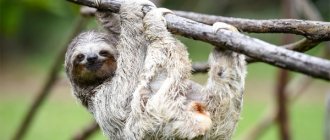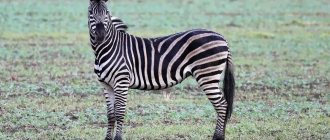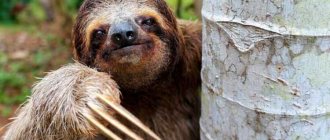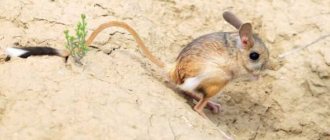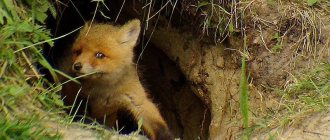Review author: “ZooVita”
This is the name in Malay for a melancholic primate with sad eyes, visually very similar to a human. Well, why the forest one is also understandable - these monkeys spend most of their lives in trees.
Recent research by scientists has proven that the DNA of humans and orangutans is 97% identical. This is less than other representatives of apes (for example, we and chimpanzees differ genetically by only one percent).
However, according to genetic scientists, they are much closer to our immediate ancestors than all other living monkeys.
Description of the orangutan
The orangutan is the largest arboreal ape.
The height of adult males reaches 1.5 m, body weight is 50-90. Females are usually much smaller: up to 1 m tall with a weight of 30 to 50 kg. Kalimantan orangutans are larger than Sumatran orangutans. The physique is massive, with highly developed muscles. The hind legs are short, the front legs are very long, reaching the ankles. The coat is sparse, reddish-brown in color, with long hair on the shoulders. The big toes rotate so that the animal can easily climb trees. — Advertising —
The head is large, the face is wide, the forehead is high, the muzzle protrudes noticeably. An adult male has characteristic growths of fat and connective tissue on his cheeks, and has a mustache and beard.
Appearance and features
Photo: Orangutan animal
The description is given for the Kalimantan orangutan - the species differ little in appearance from each other, and therefore it is almost completely suitable for others. The differences between them will be discussed separately.
The height of this monkey when raised on its hind legs is up to 140-150 cm for males and 105-115 for females. Males weigh on average 80 kg, females 40-50 kg. Thus, sexual dimorphism is expressed predominantly in size. In addition, adult males are distinguished by large fangs and a thick beard, as well as growths on the cheeks.
There is no hair on the orangutan's face and the skin is dark. He has a broad forehead and a skeletal facial structure. The jaw is massive, and the teeth are strong and powerful - they are adapted for cracking hard nuts. The eyes are set very close, while the animal’s gaze is very meaningful and seems kind. There are no claws on the fingers - the nails resemble human ones.
The orangutan has long and stiff fur, its color is brownish-red. On the head and shoulders it grows upward, on all other parts of the body downward. The animal has little hair on the palms, chest and lower part of the body, it is very thick on the sides.
The brain of this monkey is noteworthy: it is relatively small in volume - up to 500 cubic centimeters. It is far from a human with its 1200-1600, but in comparison with other monkeys, orangutans are more developed, with many convolutions. Therefore, many scientists recognize them as the smartest monkeys, although there is no single point of view on this matter - other researchers give the palm to chimpanzees or gorillas.
Sumatran orangutans differ in appearance only in that they are slightly smaller in size. The Tapanulian has a smaller head than the Sumatran. Their hair is more curly and beards grow even in females.
Interesting fact: If among the Kalimantan sexually mature males the majority have growths on their cheeks, and any of those who have them can mate with females, then among Sumatran males things are completely different - only rare dominant males acquire growths, each of which immediately controls the group females
Feeding characteristics of an orangutan
Orangutans feed mainly on fruits and tree leaves. Unlike gorillas, they are not strict vegetarians and can eat insects, bird eggs and even chicks. Sumatran orangutans sometimes hunt slow lorises. In addition, animals include honey, nuts, and tree bark in their diet. An adult orangutan can easily go without food for several days, and in general the metabolic level of these animals is quite low.
What does the “forest man” eat?
The main diet of orangutans is vegetarian. 60% are fruits (mangoes, bananas, lychees, mangosteens, figs), from which they get additional water. They eat leaves, tree bark, nuts, but, in addition to plants and fruits, they can also sometimes eat larvae, insects, mollusks, and bird eggs.
Vegetarian diet of orangutan
Monkeys are so accustomed to living in trees that even in order to get water, they may not go down to the ground, but drink from a hollow in a tree, from leaves after rain, or lick water from their fur.
Common species of orangutan
- Kalimantan orangutan (Pongo pygmaeus)
It is endemic to the island of Kalimantan, in tropical rainforests, up to an altitude of 1500 m above sea level. This is a large monkey, with males about 1.5 m tall and weighing from 50 to 90 kg. Females are usually smaller in size. The coat is thick, red-brown. The species has three subspecies.
- Sumatran orangutan (Pongo abelii)
— Advertising —
It lives in the north of the island of Sumatra in Indonesia. It is less common than its Kalimantan relative; over the past 75 years, the number of the species has decreased fourfold, which is due to environmental pollution, widespread deforestation, illegal capture of animals, sale and poaching. Externally, it is practically no different from the Kalimantan orangutan, but is inferior in size.
- Tapanul orangutan (Pongo tapanuliensis)
An isolated population of this species lives in the Batang Toru Forest, South Tapanuli, a tropical and subtropical moist broadleaf forest covering an area of about 1000 km² at altitudes ranging from 300 to 1300 meters above sea level.
In body structure and coat color it resembles the Sumatran orangutan, but differs from the latter in having more curly hair, a smaller head and a flatter face. It has developed mustaches and growths of fluffy fur on the cheeks of males. Females also have a beard. These orangutans feed rather unusually, on caterpillars and cones.
Origin of the species and description
Photo: Orangutan
Orangutans were the only surviving pongins. This subfamily previously included a number of other genera, now extinct, such as Sivapithecus and Gigantopithecus. The origin of orangutans is still not completely clear - there are several hypotheses on this matter.
According to one of them, orangutans descended from Sivapithecus, the fossil remains of which, found in Hindustan, are close in many respects to the skeleton of orangutans. Another deduces their origin from Coratpithecus, hominoids that lived on the territory of modern Indochina. There are other versions, but none of them has yet been accepted as the main one.
Video: Orangutan
The Kalimantan orangutan was scientifically described in the work of Carl Linnaeus “On the Origin of Species” in 1760. Its Latin name is Pongo pygmaeus. The Sumartan orangutan (Pongo abelii) was described a little later - in 1827 by Rene Lesson.
It is noteworthy that for a long time they were considered subspecies of the same species. Already in the 20th century it was established that these are different species. Moreover: a third species was discovered in 1997, and only in 2022, the third species was officially recognized - Pongo tapanuliensis, the Tapanul orangutan. Its representatives live on the island of Sumatra, but are genetically closer not to the Sumatran orangutan, but to the Kalimantan orangutan.
Interesting fact: the DNA of orangutans changes slowly, significantly inferior to chimpanzees or humans. As scientists suggest based on the results of genetic analysis, they are much closer than any other modern hominids to their common ancestors.
Orangutan behavior
Orangutans spend almost their entire lives in trees, moving along them with the help of long arms and supporting themselves with their legs (the arm span is about 2 m, which significantly exceeds the height of the primate).
It is interesting that the orangutan has adapted to life among trees so much that it even drinks water from leaves, hollows, or licks it off its own body after rain. Occasionally, if the animal descends to the ground, it is able to move on all four legs. For spending the night and sleeping, the orangutan builds nests for itself, but always new ones. Orangutans lead a solitary lifestyle, only babies live next to their mothers; sometimes in nature there are two females who live together. Females calmly meet each other, often searching for and eating food together. Males each stay in their own individual area and do not welcome visits from strangers. When males meet, a demonstration of strength first occurs: they growl loudly, break branches, and try in every possible way to demonstrate their superiority. If none of them retreats, then things can come to a real fight, which ends with one of the fighters giving up and running away. But in general, the disposition and character of orangutans is quite peaceful and friendly.
Orangutans cannot swim, they are afraid of water, and avoid bodies of water.
These animals are very smart. Individuals constantly use tools to obtain food. In conditions of captivity, next to a person, they can adopt the habits of people, and can even overcome their fear of water. This sometimes causes accidents, since orangutans still cannot learn to swim.
For a long time, scientists believed that orangutans are always silent. But in fact, in their conversational arsenal there are many sounds that they use in different situations: whimpering and crying express anger, irritation or pain, loud smacking and puffing is a sign of threat, and a deafening intimidating growl of a male, or a long cry is a statement to your site or a way to attract a female.
Features of character and lifestyle
Photo: Orangutans of Indonesia
These monkeys live mostly solitary and almost always stay in trees - this makes it difficult to observe them in the wild, as a result of which their behavior in the natural environment has remained poorly studied for a long time. In the natural environment, they have still been studied much less than chimpanzees or gorillas, but the main features of their lifestyle are known to science.
Orangutans are smart - some of them use tools to get food, and once in captivity they quickly adopt the habits of people that are beneficial to them. They communicate with each other using an extensive set of sounds, expressing a variety of emotions - anger, irritation, threat, warning of danger and others.
The structure of their body is ideally suited for life in trees; they can cling to branches with equal dexterity with both their arms and their long legs. They are able to move long distances exclusively through trees. They feel insecure on the ground, and therefore even prefer to sleep at a height, in the branches.
For this purpose they build nests for themselves. The ability to build a nest is a very important skill for every orangutan, which they begin to practice from childhood. Juveniles do this under adult supervision, and it takes them several years to learn how to build strong nests that can support their weight.
And this is very important, because the nest is built at a high altitude, and if it is poorly built, the monkey can fall and break. Therefore, while the cubs learn to build their own nests, they sleep with their mothers. But sooner or later there comes a time when their weight becomes too much, and the mother refuses to let them into the nest, since it may not withstand the load - then they have to begin adult life.
They try to arrange their home so that it is comfortable - they bring more leaves so that it is soft to sleep, they look for soft branches with wide leaves to cover themselves with from above. In captivity, they quickly learn to use blankets. Orangutans live up to 30 or even 40 years; in captivity they can reach 50-60 years.
Orangutan breeding
Female orangutans reach sexual maturity at the age of 8-12 years, males later - at 14-15. Pregnancy lasts approximately 8.5 months, after which usually one, sometimes two, babies are born. The weight of newborns is 1.5-2 kg, their mother feeds them with milk for 3-4 years, and they live with her until 6-8 years. Thus, the childhood of orangutans turns out to be unusually long, which is associated with their way of life: other monkeys, after leaving their mothers, live in families or packs, and single orangutans must be prepared for independent life. The lifespan of orangutans is 30 years, and in captivity it can increase significantly.
What kind of environment do huge monkeys live in?
So where does the orangutan live? Monkeys, similar in appearance to humans, live exclusively in the tropics. There are two varieties of orangutans: Bornean and Sumatran.
The habitat of great apes is swampy areas with dense forests. Orangutans are not afraid of any obstacles: they easily overcome long distances between trees.When moving along branches, animals usually use their forelimbs. The span of the orangutan's paws is simply amazing: it is approximately two meters.
The great apes orangutans are so accustomed to living in tree branches that they never go down to bodies of water. They draw water from leaves, an old hollow, or find it on their thick fur.
Young orangutans walk on the ground on all four legs. Adult monkeys prefer to walk on two legs, so they can be confused with people from local tribes.
Orangutans are unpretentious in everyday life: they go to sleep on tree branches. Some individuals make nests in the crowns of trees.
Natural enemies of the orangutan
Orangutans are endangered in the wild, mainly due to the constant destruction of their natural habitats.
National parks are being created, but illegal deforestation continues. The second serious threat to orangutans is their poaching, especially babies, for the purpose of illegal trade. At the same time, mothers are often killed, since they do not give up their cubs so easily. Sumatran and Tapanul orangutans are currently classified as critically endangered species. The status of Kalimantan orangutans is in danger.
Orangutan language
Until recently, natural scientists believed that the peculiarity of this species of primates is not only peacefulness and slowness, but also silence. However, recent observations have shown that orangutans are capable of making a variety of sounds expressing a particular emotion:
- rage manifests itself in a kind of whining and crying;
- puffing and loud smacking - this means that the primate is threatening someone;
- a loud and drawn-out cry - declaring the occupied area one’s patrimony and calling on females to take part in mating rituals.
Interesting facts about the orangutan
- The name orangutan comes from the Malay “orang utan”, which translates as “man of the forest”.
- The orangutan is easy to tame and the animal can be trained. It differs from chimpanzees in its low aggressiveness.
- Poachers often kill adults and take baby orangutans, as they are in high demand on the black market. In addition, stuffed animals are made from dead animals.
- Orangutans, like humans, can become addicted to tobacco. In the novel “The Mysterious Island” by Jules Verne, the orangutan Uncle Jupe is described, who lived with the colonists among the mountain rocks and smoked a pipe, knew how to light it himself and literally enjoyed this process along with people.
Orangutan habitat
In the recent past, orangutans could be found in many places in Southeast Asia, as evidenced by archaeological finds in Vietnam and China. Today, these monkeys remain only in the humid jungle on two islands - Barneo (or Kalimantan in Malay) and Sumatra.
Externally, primates are difficult to distinguish - the difference lies only in size.
